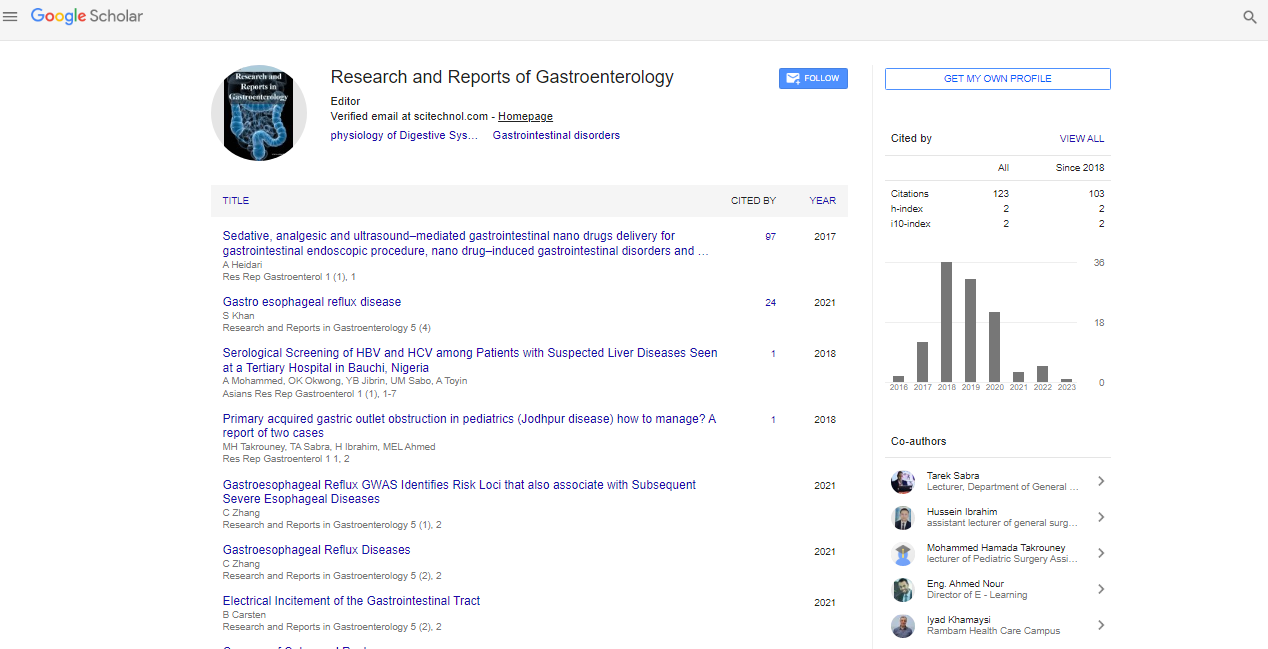Opinion Article, Res Rep Gastroenterol Vol: 7 Issue: 2
Role of MicroRNA Biomarkers in Gastrointestinal Cancer Screening and Surveillance
David Lavine*
1Department of Gastroenterology and Liver, Liverpool Hospital, Sydney, Australia
*Corresponding Author: David Lavine,
Department of Gastroenterology and
Liver, Liverpool Hospital, Sydney, Australia
E-mail: lavinedavid@gmail.com
Received date: 15 May, 2023, Manuscript No RRG-23-106623;
Editor assigned date: 17 May, 2023, PreQC No RRG-23-106623(PQ);
Reviewed date: 01 June, 2023, QC No RRG-23-106623;
Revised date: 08 June, 2023, Manuscript No RRG-23-106623 (R);
Published date: 16 June, 2023, DOI: 10.4172/Rrg.1000145
Citation: Lavine D (2023) Role of MicroRNA Biomarkers in Gastrointestinal Cancer Screening and Surveillance. Res Rep Gastroenterol 2023, 7:2.
Abstract
Description
Gastrointestinal (GI) cancers, including colorectal, gastric, pancreatic, and esophageal cancers, are a significant global health burden. Early detection plays a major role in improving patient outcomes, as it allows for timely intervention and treatment. Micro Ribonucleic Acids (miRNAs) have emerged as promising biomarkers for the screening and surveillance of GI cancers.
MicroRNAs and cancer
MicroRNAs are small non-coding RNA molecules that regulate gene expression. They play vital roles in various cellular processes, including cell proliferation, differentiation, and apoptosis. Dysregulation of miRNAs has been implicated in cancer development and progression. Altered expression levels of specific miRNAs have been observed in GI cancers, making them attractive candidates as diagnostic and prognostic biomarkers.
Colorectal cancer
Colorectal cancer (CRC) is a common GI malignancy with a high mortality rate. The use of miRNA biomarkers in CRC screening and surveillance has shown promise. Numerous studies have identified specific miRNAs that are differentially expressed in CRC tissues and body fluids, such as blood and stool. These miRNAs can serve as diagnostic markers for CRC and may have potential prognostic value. Additionally, miRNA panels have been developed to improve the accuracy of CRC detection and risk stratification.
Gastric cancer
Gastric cancer is a leading cause of cancer-related deaths worldwide. MiRNA biomarkers have been investigated for their utility in gastric cancer screening and surveillance. Altered expression of miRNAs in gastric cancer tissues and biofluids has been observed, highlighting their potential as diagnostic and prognostic markers. Specific miRNAs, such as miR-21, miR-106a, and miR-451, have been associated with gastric cancer development and may serve as potential biomarkers for early detection and monitoring.
Pancreatic cancer
Pancreatic cancer is characterized by late-stage diagnosis and poor prognosis. MiRNA biomarkers offer hope for improving early detection and surveillance. Several miRNAs, including miR-21, miR-155, and miR-196a, have shown altered expression in pancreatic cancer tissues and biofluids. These miRNAs have the potential to serve as diagnostic and prognostic markers, aiding in the early detection and management of pancreatic cancer.
Esophageal cancer
Esophageal cancer is a highly aggressive malignancy with a dismal prognosis. MiRNA biomarkers have been investigated for their utility in esophageal cancer screening and surveillance. Dysregulated miRNA expression patterns have been identified in esophageal cancer tissues and biofluids, offering potential diagnostic and prognostic value. Specific miRNAs, such as miR-21, miR-143, and miR-203, have shown promise as biomarkers for esophageal cancer detection and surveillance.
Benefits and challenges
The use of miRNA biomarkers in GI cancer screening and surveillance offers several advantages. MiRNAs can be easily detected in non-invasive samples, such as blood, stool, and saliva, making them attractive for routine screening and monitoring. They can provide early indication of cancer development, facilitate risk stratification, and guide personalized treatment decisions. However, challenges remain, including the need for standardized detection methods, validation in large prospective studies, and addressing the heterogeneity of miRNA expression across different cancer types and patient populations.
Conclusion
MiRNA biomarkers hold great potential for the screening and surveillance of GI cancers. They offer non-invasive, easily accessible tools for early detection, risk stratification, and monitoring of these malignancies. The identification of specific miRNA signatures associated with GI cancers opens avenues for developing accurate and personalized diagnostic approaches. However, further research is needed to validate and standardize miRNA biomarkers and their detection methods in large, well-designed clinical trials. With continued advancements in miRNA research, these biomarkers have the potential to significantly improve the management and outcomes of GI cancer patients.
 Spanish
Spanish  Chinese
Chinese  Russian
Russian  German
German  French
French  Japanese
Japanese  Portuguese
Portuguese  Hindi
Hindi 